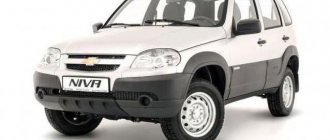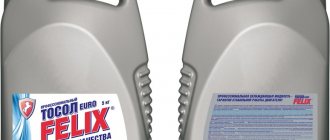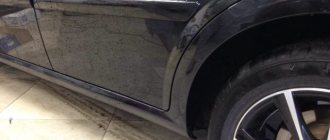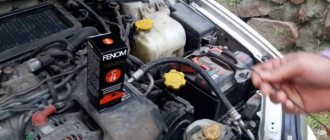Modern engines are designed on the principle of delivering maximum power while limiting displacement. Under such conditions, increased wear of the piston group is observed, even with relatively moderate mileage of the vehicle. The Suprotec Active Diesel additive is designed to care for such units and reduce wear.
Increased compression ratio
The main difference is the method of ignition of the air-fuel mixture. In gasoline engines, this function is performed by spark plugs; in diesel engines, the fuel ignites due to the strong heating of the air when compressed in the cylinder. The compression ratio in diesel engines is one and a half to two times higher (14-18 versus 8-12). Increased compression allows you to work on lean fuels. In principle, diesel will be able to function for some time even on crude oil.
The downside of an increased compression ratio is the breakthrough of combustion products through the piston clearances into the crankcase. Chemically aggressive gases heated to extremely high temperatures will inevitably “kill” even the best oil for diesel engines. The chemical composition, and with it the performance characteristics of the lubricating fluid, will deviate from standard values.
Effect of use
Tribotechnical compounds of the “Active Plus” series create conditions under which the surfaces in engine friction units are covered with a metal protective layer with a special structure. This layer partially restores the dimensions and geometry of worn parts, optimizes gaps in friction pairs, and retains more oil on friction surfaces.
This provides the following effects from the use of the composition:
- Increased power and fuel economy - partial restoration of CPG wear and a dense oil layer seal the gaps in the cylinder-piston group and provide the necessary gas tightness. This restores compression and equalizes it across the cylinders, improving the quality of fuel combustion. In addition, a dense oil layer shifts the friction mode towards hydrodynamic, which reduces friction losses. All this leads to an increase in engine power while simultaneously saving fuel by 6-8%.
- Reduced oil loss - the protective layer restores the density of the liner - ring - piston groove assembly. This improves oil removal from the cylinder walls and reduces its waste in the combustion chamber, especially at increased engine speeds.
- Reducing vibration and noise - restoring and equalizing compression across the cylinders leads to their smooth operation. In addition, a dense layer of oil softens the shifting of the pistons. All this reduces vibration and noise in the engine.
- Reduced toxicity and smoke - restoring compression and optimizing clearances in the cylinder-piston group ensures high-quality fuel combustion and reduces oil waste, which leads to a decrease in engine toxicity and smoke.
- Restoring the functional properties of hydraulic compensators - the protective layer restores the wear of hydraulic compensator parts and improves their fit, which normalizes oil pressure and ensures high-quality operation of the mechanism.
- Increased service life - the protective layer significantly reduces the wear rate of the most loaded friction parts, which determine the service life of the engine.
- Protection under increased loads – the protective layer prevents wear of friction parts under increased loads much more effectively due to structural features (microhardness and microelasticity) and retention of more oil.
- Facilitation of starting and protection during “cold start” - treated surfaces are able to retain the oil layer during long periods of inactivity. This makes it easier to make the first revolutions and prevents increased engine wear due to oil starvation at the time of start-up, which is especially important at negative ambient temperatures.
- Protection during active driving - treated surfaces retain a denser oil layer, which reduces wear and compensates for oil starvation during moments of rapid engine speed.
Fuel composition
Diesel engine oil must have improved dispersing and detergent properties in order to effectively remove carbon deposits from parts. Diesel fuel is very different from gasoline in composition; it contains more sulfur and heavy hydrocarbon compounds. When such fuel burns, a large amount of soot and soot is formed.
Developers introduce alkaline additives motor oil for diesel engines This measure is designed to neutralize the corrosive effect of sulfur compounds, which, when in contact with water vapor in the exhaust gases, form sulfuric acid. Additives allow you to keep the acid number of the lubricant longer at a level that is safe for the engine.
Additive Suprotek Active Plus Diesel for diesel engines
Under the influence of the tribological composition, a protective metal layer is formed on worn areas of parts, which is capable of holding the engine oil film more tightly. This allows you to solve the following problems:
Restore and equalize compression across the cylinders.
Partial restoration of the shape of the cylinders and a dense oil film on their surface seal the gaps in the cylinder-piston group between the compression rings and the cylinder walls, which ensures the necessary gas tightness.
This prevents gas breakthrough, and accordingly restores compression and equalizes it across the cylinders. Treatment with a tribo-composition cannot increase compression beyond the nominal one provided for this particular engine, which makes the use of the composition safe.
Reduce oil consumption due to waste.
The protective layer restores the density of the liner - ring - piston groove assembly. This improves oil removal from the cylinder walls and reduces its waste in the combustion chamber, especially at increased engine speeds.
If oil consumption is associated with other reasons: “hardened” oil seals or destruction of valve stem seals, the tribo compound will not be able to solve this problem. More information on how you can independently determine the cause of oil consumption can be found here.
Eliminate noise when hydraulic compensators operate.
The protective layer restores the shape of the hydraulic compensator plunger surface, optimizes clearances, which prevents oil breakthrough and normalizes its pressure.
This ensures high-quality and silent operation of the mechanism.
Reduce vibration and noise during engine operation.
Restoring and equalizing compression across the cylinders leads to smooth engine operation.
In addition, a dense layer of oil softens the shifting of the pistons. All this reduces vibration and noise in the engine.
Restore oil pressure in the system.
A drop in oil pressure occurs due to an increase in gaps in the friction pairs of the CPG, as well as due to pump wear.
Restoring friction surfaces leads to optimization of gaps. At the same time, the oil pump raises the output pressure to the nominal value, reducing pressure losses due to expanded gaps in the CPG, in the cylinder head, and in the crankshaft.
Reduce fuel consumption.
Restoring and equalizing compression ensures more complete combustion of fuel and reduces losses due to gas breakthrough.
A dense oil film expands the hydrodynamic friction zone, which reduces friction losses. While maintaining the driving mode, this provides a reduction in fuel consumption by 6-8% for cars with high mileage. In new cars, it helps to avoid increased fuel consumption by significantly slowing down wear processes.
Increase engine power and throttle response.
Restoring and equalizing compression ensures more complete combustion of fuel and reduces losses due to gas breakthrough.
A dense oil film expands the hydrodynamic friction zone, which reduces friction losses. Taken together, this leads to an increase in the power obtained per unit of fuel and an improvement in the dynamic characteristics of the engine.
Get rid of exhaust smoke and reduce its toxicity.
Restoring compression and optimizing clearances in the cylinder-piston group ensure high-quality fuel combustion and reduce oil waste.
This reduces the content of unburnt fuel particles and oil combustion products in the exhaust gases, which reduces their smokiness and toxicity.
In addition to solving current problems, the use of tribocomposition allows achieving preventive effects:
Make it easier to start the engine and reduce its wear during cold starts.
A drop in oil pressure occurs due to an increase in gaps in the friction pairs of the CPG, as well as due to pump wear.
Restoring friction surfaces leads to optimization of gaps. At the same time, the oil pump raises the output pressure to the nominal value, reducing pressure losses due to expanded gaps in the CPG, in the cylinder head, and in the crankshaft.
Protect the engine from wear under increased loads.
Due to its structural features, the protective layer has increased microelasticity (deforms during a collision and then restores its shape instead of being destroyed) and microhardness (does not collapse when loads from wear particles occur).
A denser oil film on the surface of the layer also reduces direct contact of parts and withstands increased thermal and mechanical loads. All this allows you to reduce engine wear, especially during long periods of idle time in traffic jams, when the oil overheats and liquefies, when maneuvering at low speeds or when they rise sharply, when oil starvation occurs.
Protect the engine in case of emergency oil loss.
The oil film, held on the protective layer due to its structural features, can protect the engine from scuffing and jamming in the event of a sudden drop in oil pressure.
This allows you to avoid breakdowns if oil loss or pressure drop was not noticed immediately. In addition, in some cases (depending on the design of a particular engine), this allows you to safely drive the car to a service station under its own power.
Reduce oil consumption due to waste.
The protective layer restores the density of the liner - ring - piston groove assembly.
This improves oil removal from the cylinder walls and reduces its waste in the combustion chamber, especially at increased engine speeds. If oil consumption is associated with other reasons: “hardened” oil seals or destruction of valve stem seals, the tribo compound will not be able to solve this problem. More information on how you can independently determine the cause of oil consumption can be found here
SIGNS OF ENGINE WEAR
There are various signs that the wear of engine components is approaching critical. As a rule, increasing wear is characterized by a decrease in engine dynamics and an increase in average fuel consumption under the same driving conditions.
Listed below are some more common signs of wear, in which treating the engine with a tribo compound can significantly delay the need for repairs:
An “iron ringing” sound appeared when starting the engine
Due to wear on the cylinder walls, the gaps between them and the piston rings widen.
When starting the engine, when it is cold and the clearances have not yet decreased due to thermal expansion of the parts, the piston can make transverse movements accompanied by an impact. A quick sequence of impacts merges into a general “ringing”, the engine “rattles”. This is especially noticeable when starting in the cold, when the gaps are widened even more. This indicates that the cylinder surfaces are heavily worn, and each such start wears them out even more.
There was constant blue smoke in the exhaust.
Blue smoke means that oil is constantly entering the combustion chambers, which indicates widened gaps in the cylinder-piston group due to wear of the cylinder walls and piston rings.
The tribotechnical composition is able to restore worn surfaces, remove smoke and oil consumption. If blue smoke appears only when starting the engine and then disappears, you need to check the valve stem seals. Most likely, during idle time, oil flows through them and accumulates in the combustion chambers. In this case, the tribo compound will not help, since the valve stem seals are made of rubber.
The engine began to run louder, harder, and vibration appeared.
These signs may indicate that the compression balance is imbalanced.
The pistons in different cylinders push with different forces, which disrupts the smooth operation of the engine. If this symptom appears suddenly and suddenly attracts attention, it is possible that a breakdown has occurred - for example, a piston ring has burst. If vibration and noise increased gradually, imperceptibly, then most likely this is the result of wear of the cylinder head, in which case the tribotechnical composition will be able to restore worn surfaces and eliminate signs of wear.
A “clattering sound” of the hydraulic compensators appeared when the engine warmed up.
A rattling sound when the engine is running “cold” indicates that the hydraulic compensators cannot maintain oil pressure due to wear on the plunger surface.
During engine operation, they heat up, thermal gaps disappear, and pressure loss does not occur so quickly. However, the “clatter” that appears indicates that further wear on the plungers will only increase and will lead to the need to replace the hydraulic compensators. Treating the engine with a tribo compound can help solve this problem without disassembling the engine.
The “consumer effects” section below describes in detail which characteristics are restored and why.
ORDER OF APPLICATION
Full treatment will require three bottles of the composition. Added to the oil filler neck. Does not require any special knowledge or tools.
Adding the composition to motor oil can be done by any car owner in any passenger car independently. However, it is important to pay attention to the instructions included with each bottle of the composition so that it works as effectively as possible.
The standard processing procedure is as follows:
- A bottle of the composition is added to the oil approximately 1000 kilometers before the planned regular oil change.
- Another bottle of the composition is added after replacement to fresh oil and works there throughout the entire service interval.
- The third time the bottle of the composition must be added after the next oil change. At the same time, it is more profitable to purchase not separate compounds, but a set for a full processing cycle.
OPERATING PRINCIPLE
Under the influence of the tribological composition, a protective metal layer is formed on worn areas of parts, which is capable of holding the engine oil film more tightly.
Restored shape and dimensions + denser oil film on the surface -> normal operation of the part.
The tribological composition contains particles of active mineral. When they enter zones of local surface contacts, where high local pressure occurs and the temperature exceeds 1000 C, the mineral particles change the course of friction processes. The surface of the part is able to “capture” microparticles of metal contained in the lubricant. Gradually, a continuous metal protective layer is formed over the entire worn surface, the peculiarity of which is a porous structure with a large number of micro-grooves. Particles of the mineral itself remain in the oil and continue to have the necessary effects in other areas.
The micropores of the protective layer are filled with oil, which, due to surface tension forces, forms a continuous film on it. This oil film never completely separates from the surface of the part and does not drain, even during long periods of inactivity. The protective layer itself is able to withstand heavy loads due to increased microhardness and microelasticity compared to the original factory surface.
Restoration of shape and more effective lubrication allow the part to perform its functions as it was intended in the engine design, which leads to the restoration of the performance characteristics of all friction units.
Synthetic or mineral?
When deciding which diesel engine oil is preferable to buy , many car enthusiasts find it difficult to choose between expensive “synthetic” and affordable “mineral”. In our case, the principle “more expensive means better” does not work.
For a diesel engine, it is not so important what kind of oil is poured into it - synthetic, semi-synthetic or mineral. It is not the basis that is of decisive importance. Much more important are the physical and technical parameters of the lubricating fluid: viscosity, total base number, flash point and fluidity loss.
The choice is influenced by the intensity of use of the vehicle and the type of engine. For example, for turbocharged diesel engines it is better to buy synthetic oil : it retains its performance properties longer. Also, “synthetics” are preferable when used in regions with harsh winters (read more: “Synthetics, semi-synthetics, hydrocracking - how to determine?”...).
Synthetic motor oil "Suprotec Atomium" 5W-30 4l
Synthetic motor oil with viscosity grade 5W-30. Buy oil with a manufacturer's warranty.
more reviews
Application
The tribotechnical composition Suprotec Active is intended for the care of modern diesel engines with a mileage of less than 50,000 km. There is full compatibility with forced, highly loaded units equipped with turbocharging and direct fuel injection. The additive does not harm the latest generation of particulate filters and is compatible with any exhaust gas afterburning devices.
The liquid is also compatible with any types of diesel oils, without reacting with them and without changing their original properties.
The manufacturer insists on suitability for servicing passenger cars, trucks and passenger cars.
How to choose motor oil for diesel engines by viscosity
This is the main parameter that determines most of the performance characteristics of the oil, and therefore the engine. Viscous oil for diesel engines forms a thick enough layer on the rubbing parts to protect them from wear, but thickens in cold weather so that it becomes impossible to start the engine. When the temperature rises, a lubricant that is too thin cannot protect friction pairs from wear, but remains fluid in frosty weather. Properly selected oil allows you to avoid extremes in engine operation and extend its life.
Advantages and disadvantages
The main advantages of Suprotec asset plus diesel are:
- increasing cylinder compression and oil pressure levels;
- reduction of oil waste;
- increase in engine life by 1.5 - 2 times;
- reduction in diesel fuel consumption by 10%;
- restoring engine power to factory parameters;
- reduction of vibration and noise in the engine compartment;
- reliable protection of the internal combustion engine from wear.
Some motorists note that the effect of using the product does not occur immediately, but this can easily be explained by its composition and specific action.
Viscosity Standard
The label of the container with the lubricating fluid must indicate the product marking according to the SAE standard (read more: “What is the viscosity index?”...). Examples of such markings: 10W-40 or 5W-30. These are universal oils that can be used all year round. Today, purely “winter” and “summer” liquids are almost never found on sale. Now you need to understand these numbers and letters.
The first number with the English letter W indicates low-temperature viscosity. For example, 5W retains its properties at temperatures down to -30 °C. That is, you can start the car even in severe frost. The 25W marking indicates that the oil will become too thick at -5°C.
The second number is the summer viscosity coefficient. The higher the value, the higher the temperature at which the oil’s performance characteristics are maintained. Simply put, a product labeled 5W-40 is thicker than 5W-30.
Synthetic motor oil "Suprotec Atomium" 5W-40 1l
Synthetic motor oil with viscosity grade 5W-40. Buy oil with a manufacturer's warranty.
more reviews
Contrary to the prevailing opinion among some car enthusiasts, the grade of oil for a diesel engine has nothing to do with the base. That is, a more “sophisticated” 0W-50 is not always an expensive “synthetic”, and a simple 15W-20 is not necessarily a “mineral water”. The properties of a lubricating fluid depend more on the additive complex rather than on the base (read more: “What is SAE?”...).
Which diesel engine oil to buy, taking into account performance characteristics
Viscosity is an important, but not the only parameter for determining grade. To identify the best oil for a diesel engine , you need to take into account a number of other properties. What matters is the ability of a lubricant to carry away wear products from rubbing parts, neutralize acidic components in exhaust gases, and also dissolve and wash away carbon deposits.
Synthetic motor oil "Suprotec Atomium" 5W-40 4l
Synthetic motor oil with viscosity grade 5W-40. Buy oil with a manufacturer's warranty.
more reviews
API
The generally accepted reference point for the properties of lubricating fluids is the API standard (read more: “API Classification”...). It was developed by the US Petroleum Institute in 1969 and is constantly updated. Oils for diesel engines are designated in this classification by the letter C. The second letter is used for more precise gradation.
- CE - oils for diesel turbocharged engines since 1983. They work in high-power motors with different engine speeds.
- CF – for diesel engines with indirect injection. Allows the use of fuel with a sulfur content of 0.5% or more. Approved in 1990.
- CF-4 – lubricants for high-speed diesel engines of long-haul tractors, etc.
- CG-4 – for diesel engines operating under high loads (buses, trucks, etc.), produced since 1995. Demanding on fuel quality.
- CH-4 - oils for diesel engines with turbines produced since 1998. Allows sulfur content in fuel of more than 0.5%, which is especially important for Russia.
- CI-4 – for diesel engines with different injection and supercharging systems produced since 2002.
- CJ-4 is a lubricant for heavy-duty power plants produced since 2006.
- SN – motor oil for engines with modern exhaust gas aftertreatment systems. Allows you to reduce fuel consumption.
Synthetic motor oil "Suprotec Atomium" 5W-30 1l
Synthetic motor oil with viscosity grade 5W-30. Buy oil with a manufacturer's warranty.
more reviews
Motor oils for diesel engines of classes CA, CB, CC and CD are obsolete and are practically not found on the market today. Some brands have double markings; they can be used in both diesel and gasoline engines. A small clarification: the preferred use label comes first. For example: CI-4/SJ lubricant is better suited for diesel engines, while SJ/CI-4 is more suitable for gasoline engines.
Product Description
The artificial fluid Suprotek Active is made by combining a set of advanced components that reduce the frictional loads of moving engine parts. The mixture coats the parts with a dense layer of metal particles of minimal size, which helps to hold the oil on vertical surfaces. The operating principle improves the effectiveness of the main lubrication and minimizes starting wear of the motor.
Additionally, the membrane prevents abrasion of surfaces when the power plant is overloaded. Metal particles have good microhardness, which increases the resistance to the mechanism of mechanical destruction.
ACEA standard
The Association of European Automobile Manufacturers has developed a standard regulating a large number of parameters of motor oils for diesel engines . The standard classifies materials without dividing them by fuel type. Category A/B combines lubricants for gasoline and diesel engines of passenger cars.
Category C includes motor oils for modern diesel and gasoline engines that meet Euro-4 standards. Category E is motor oils for powerful motors installed in trucks and buses.
The numerical values after the letters indicate the grade: the higher the number, the higher the quality.
Which diesel engine oil to buy
There is such a variety of motor oils for diesel engines that choosing becomes a very difficult task. Many car enthusiasts follow the established pattern, buying products from well-known companies. Yes, you have to overpay “for the brand,” but you have confidence in the quality. At the same time, there are samples of little-known brands on the market, which in their characteristics are not inferior to well-known brands. One of these products is domestic oil for diesel and gasoline engines Suprotec Atomium.
This is a fully synthetic product certified to SAE 5W-30, ACEA C3 and API SN standards. The composition was developed by the German concern Rowe Mineraloelwerk by order of NPTK Suprotek.











